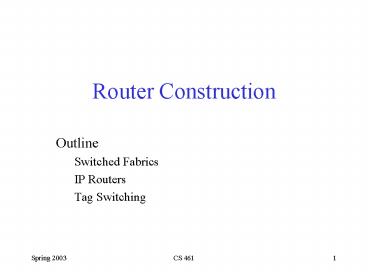Router Construction PowerPoint PPT Presentation
Title: Router Construction
1
Router Construction
- Outline
- Switched Fabrics
- IP Routers
- Tag Switching
2
Workstation-Based
- Aggregate bandwidth
- 1/2 of the I/O bus bandwidth
- capacity shared among all hosts connected to
switch - example 1Gbps bus can support 5 x 100Mbps ports
(in theory)
- Packets-per-second
- must be able to switch small packets
- 300,000 packets-per-second is achievable
- e.g., 64-byte packets implies 155Mbps
I/O bus
CPU
Interface 1
Interface 2
Interface 3
Main memory
3
Switching Hardware
- Design Goals
- throughput (depends on traffic model)
- scalability (a function of n)
- Ports
- circuit management (e.g., map VCIs, route
datagrams) - buffering (input and/or output)
- Fabric
- as simple as possible
- sometimes do buffering (internal)
4
Buffering
- Wherever contention is possible
- input port (contend for fabric)
- internal (contend for output port)
- output port (contend for link)
- Head-of-Line Blocking
- input buffering
2
Port 1
Switch
2
1
Port 2
5
Crossbar Switches
6
Knockout Switch
Inputs
- Example crossbar
- Concentrator
- select l of n packets
- Complexity n2
1
2
3
4
Outputs
7
Knockout Switch (cont)
- Output Buffer
Shifter
(a)
Buffers
Shifter
(b)
Buffers
Shifter
(c)
Buffers
8
Self-Routing Fabrics
- Banyan Network
- constructed from simple 2 x 2 switching elements
- self-routing header attached to each packet
- elements arranged to route based on this header
- no collisions if input packets sorted into
ascending order - complexity n log2 n
001
001
011
110
011
111
110
111
9
Self-Routing Fabrics (cont)
- Batcher Network
- switching elements sort two numbers
- some elements sort into ascending (clear)
- some elements sort into descending (shaded)
- elements arranged to implement merge sort
- complexity n log22 n
- Common Design Batcher-Banyan Switch
10
High-Speed IP Router
- Switch (possibly ATM)
- Line Cards
- link interface (input, output)
- router lookup (input)
- common IP path (input)
- packet queue (output)
- Control Processor
- routing protocol(s)
- exceptional cases
11
IP Forwarding is Slow
- Problem classless IP addresses (CIDR)
- Route by variable-length Forwarding Equivalence
Classes (FEC) - FEC IP address plus prefix of 1-32 bits e.g.,
172.200.0.0/16 - IP Router
- forwarding tbl ltFECgt ltnext hop, portgt
- match IP address to FEC w/ longest prefix
12
ATM Forwarding
- Primary goal fast, cheap forwarding
- 1Gb/s IP router 187,000
- 5Gb/s ATM switch 41,000
- Create Virtual Circuit at Flow Setup
- ltin VCIgt ltport, out VCIgt
- Cell Forwarding
- index, swap, switch
13
Cisco Tag Switching
- Add a VCI-like tag to packets
- ltin taggt ltnext hop, port, out taggt
- TSR uses ATM switch hardware
- IP routing protocols (OSPF, RIP, BGP)
- build forwarding table from routing table
- Goal IP router functionality at ATM switch
speeds/costs
14
Forwarding
- Shim before IP header
- Tag Forwarding Information Base (TFIB)
- ltin taggt ltnext hop, port, out taggt
- Just like ATM
- index, swap, switch
15
Tag Binding
- New FEC from IP routing protocols
- Select local tag (index in TFIB)
- ltin taggt ltnext hop, port, ???gt
- Need ltout taggt for next hop
- Other routers need my ltin taggt
- Solution distribute tags like other routing info
16
Tag Distribution Protocol
- Send TDP messages to peers
- ltFEC, my taggt
- Upon receiving TDP message, check if sender is
next hop for FEC - yes, save tag in TFIB
- no, can discard or save for future use
- Control-driven label assignment
17
The First Tag
- Two kinds of routers edge vs. interior
- Edge add shim based on IP lookup, strip at exit
- Interior forward by tag only
18
Robustness Issues
- What if tag fault?
- try to forward (default route)
- discard packet
- Forwarding Loops
- topology changes cause temporary loops
- TTL field in tag, same as IP
19
Ipsilon IP Switching
- Run on ATM switch over ATM network
- ATM hardware IP switching software
- Idea Exploit temporal locality of traffic to
cache routing decisions - Associate labels (VCI) with flows
- forward packets as usual
- main difference is in how labels are created,
distributed to other routers
20
IP Switch
- Assume default ATM virtual circuits between
routers - Router runs IP routing protocol, can forward IP
packets on default VCs - Identify flows, assign flow-specific VC
- flow port pair or host pair
- Data-driven label assignment
21
Flow Setup on IP Switch
Controller
- ltvci xgt ltport c, vci xgt
- Get IFMP, ltvci xgt ltport j, vci ygt
Port c
vci x
IFMP message
IFMP message
ltflowID, vci x, lifegt
ltflowID, vci y, lifegt
vci x
vci y
Port i
Port j
ATM Switch
22
Comparison
IP Switching
Tag Switching
- Switch by flow
- Data driven
- Soft-state timeout
- Between end-hosts
- Every router can do IP lookup
- Scalable?
- Switch by FEC
- Control driven
- Route changes
- Between edge TSRs
- Interior TSRs only do tag switching

